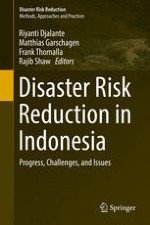2017 | OriginalPaper | Chapter
25. Measuring Community Resilience to Natural Hazards: Case Study of Yogyakarta Province
Authors : Herryal Z. Anwar, Emilia Yustiningrum, Nina Andriana, D. T. P. Kusumawardhani, Saut Sagala, Anggun Mayang Sari
Published in: Disaster Risk Reduction in Indonesia
Publisher: Springer International Publishing
Activate our intelligent search to find suitable subject content or patents.
Select sections of text to find matching patents with Artificial Intelligence. powered by
Select sections of text to find additional relevant content using AI-assisted search. powered by
